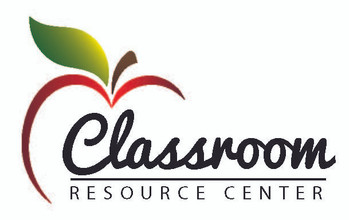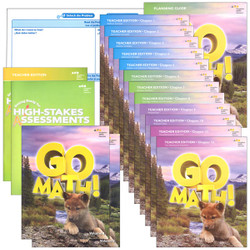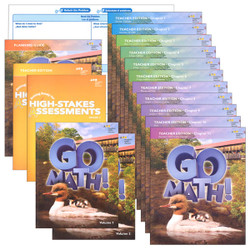Go Math 2016 Grade 6 Homeschool Bundle
Over the years, Go Math has provided trusted content to over seven million students in every U.S. State and 72 countries. A research report by the Harvard University Center for Education Policy shows significant positive achievement for students using Go Math. GO Math! K–6 is an award winning curriculum that offers an engaging and interactive approach to covering state standards. Its seamless digital path and Write-in Student Edition ensure appropriate levels of depth and rigor. Exciting new features for students and teachers are always being added as this series has been designed from the ground up to meet the demands and exceed state standards.
Go Math! Bundles are kits that have been created for homeschool classrooms; however, the books included are the same as used in public and private school settings. Bundles include the necessary materials for teacher and one student for each level - Student Edition Set, Teacher Edition with Planning Guide and High Stakes Assessment Student and Teacher Edition. They also include a dry erase math board which helps students think through the solving of problem.
Kit Components:
| ISBN/Material Number | Title | QTY |
| 9780544604803 / 1616503 | Go Math! Getting Ready for High Stakes Assessments, Teacher Edition Grade 6 | 1 |
| 9780544601970 / 1616509 | Go Math! Getting Ready for High Stakes Assessments, Student Edition Grade 6 | 1 |
| 9780544745612 / 1632761 | HMH GoMath! Student Edition Set (StA) Grade 6 | 1 |
| 9780544745896 / 1632889 | HMH GoMath! Teacher Edition and Planning Guide (StA) Bundle Grade 6 | 1 |
| 9780544764972 / 1635243 | HMH GoMath! Styrene Mathboard Grades 5-6 | 1 |
| 1649314 | HMH GOMATH HMSCHL PKG FLYER K-6 | 1 |
Go Math (HMH) Program Review
Please note that although digital resources are mentioned throughout the teacher's material and student books, most of these are not available in the bundles. Although these do sound interesting, access to the digital resources is not necessary to use the program.
Opening the cover and flipping through the first several pages of the student math books in this series may leave you a bit confused. Take the 2nd grade for example. The first page is a gorgeous picture of a whale and the next several pages, with equally beautiful photos, talk about the different kinds of whales and where they are usually found. Theres even a map on most pages so you can pinpoint the location. Accompanying questions Where is the Pacific Ocean on the map? will do nothing to help sort things out. Did you just drop into a geography lesson thinking you were in math? Nope! This really is math at its newest and cross-curricular best. Perhaps I should have mentioned the part where the scientist sees a group of 27 fin whales how many tens in the number 27?
Fun is integral to this program something that is often sought in math programs but rarely found. Student books are colorful; chapters are introduced with interesting trivia-types of information that is somehow always math related. For instance, the White House has 412 doors and 147 windows; suppose 10 parrot fish are eating at a coral reef . . . . Photos (i.e. parrot fish, White House) engage the eyes as well as the mind. Introductory activities typically include review, games, vocabulary activities, more games all under the heading of Show What You Know and ending with Write Way, a journal-type writing activity. Lessons are consistent in daily format but have a progression through a chapter. Lesson components include Listen and Draw (hands on activities), Share and Show (related problems), On Your Own (small set of problems), Problem Solving/Application (word problems), and Practice and Homework pages that include Lesson Check and Spiral Review problems. The Teacher books lead the student through these lesson components as an interactive dialog and incorporating activities.
Digital Resources are mentioned throughout the teachers material and to a lesser degree in the student books. However, its important to note that most of these resources are not available with the purchase of the homeschool packages. The exception to this is the well-done and entertaining Math on the Spot videos that are accessed via QR codes in the Student Books. Examples similar to various problems in the Student Books are worked step-by-step by a teacher sort of real person talking to a muppet sort of student. Unavailable resources include interactive teachers and student versions of the text, a Personal Math Trainer (additional practice), animated math models, and some virtual manipulatives. While some of these sound interesting, none of them are integral to the program.
There is a progression through the chapters. For instance, the 2nd grade chapter on 3 Digit Addition and Subtraction has these lessons: draw to represent 3 digit addition; break apart 3-digit addends (separate into hundreds, tens, ones); 3-digit addition, regroup ones; 3-digit addition, regroup tens; addition, regroup ones & tens; problem-solving, 3 digit subtraction; 3-digit subtraction, regroup tens; 3-digit subtraction, regroup hundreds, subtraction, regroup hundreds & tens; regrouping with zeros. A glossary in pictures in the early elementary courses in the back of both student and teacher books provides consistent definitions.
Engage, Explore, Explain, Elaborate, and Evaluate. These are the core elements of this program; designed to capture childrens interest, to communicate that math is involved in all aspects of their lives, to give them the opportunity to multi-sensorially delve into math concepts while at the same time systematically practicing and reviewing what has been learned. The Teachers and Student Books work together providing instructional dialog, manipulative-based illustration of concepts, worked examples, reinforcement games and monitored practice. This is probably a good place to mention that while it will be very tempting to try to do this course with just the Student Books since they are available as a set, there is practically no instruction in them and the teacher will find herself having to supply instructional content (as well as answers) with minimal cues.
The Planning Guide provides daily lesson plans, a chapter pacing chart, sections on daily classroom management as well as differentiated and specialized instruction; plus a wealth of math educational philosophy. Please note that there is mention in the Planning Guide of various online resources that are not available for homeschoolers using this material. The publishers have selected from the course components the elements they believe make a cost-effective yet complete set of materials for homeschoolers.
While this program obviously pays a lot of attention to its Es, there is a C and an M that are conspicuously missing. Computational practice is minimal. In fact, daily lessons have surprisingly few problems with the number of daily practice and homework problems range from just a handful in the lower grades to averaging 10-20 in the upper grades. Also missing is any emphasis on the Memorization of math facts. While some may applaud this de-emphasis, others might find they would like to add some sort of supplemental workbook and/or fact drill especially for students who take longer to master concepts.
The consumable, two-volume Student Editions are colorful with perforated pages. Lots of space is provided for students to work problems and complete related writing and drawing activities. Teacher Editions are a set of large (9.75 x 12), magazine-size handbooks for the teacher; one handbook for each chapter. These provide reduced copies of student pages (with answers filled in) and instructional information along the sides. Lessons are scripted with an ongoing teacher-student dialog provided in the sidebars as are suggestions for differentiated instruction. One of the special facets of this curriculum is the cross-curricular applications, some of which are found in the Student books and some in the Teachers.
Mid-Chapter Checkpoints and Chapter Review/Tests are provided in the Student Books (answers in Teacher Editions). However, assessment is broader than just course tests and crosses over into preparation for the High Stakes Assessment Testing becoming standard in elementary schools. Providing a format that replicates the computer-based questions that distinguish those tests, the black and white Assessment Books provide beginning/middle/end-of-the-year assessments as well as Performance Tasks for those same checkpoints. Test-taking strategies are explained throughout. Student Assessment Books provide non-reproducible copies of the various assessments while the Teacher Assessment Books provide filled-in, reduced-size test pages and scoring rubrics.
Providing a problem-solving space for the frequent requests for student-generated illustrations, the write-on/wipe-off, double-sided MathBoard (12 x 17) has questions in both English and Spanish as well as various rules (i.e. inches, centimeters, number line, etc.). This board is used for the Quick Pictures, Problem of the Day, Share and Show, and Essential Question portions of the Lessons.
Go Math Bundles include the Student Edition (2 volumes), the Teacher Edition (chapter booklets), a Planning Guide, access to Math on the Spot Videos, a bilingual MathBoard, and both Student and Teacher editions of the Getting Ready for High Stakes Assessment Workbook.







